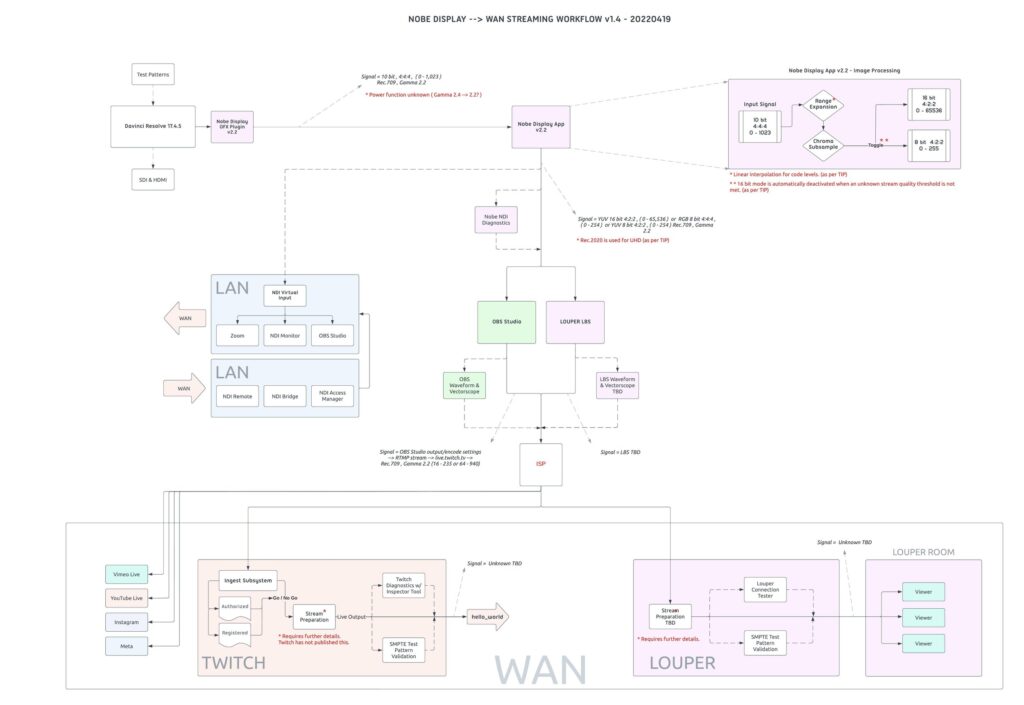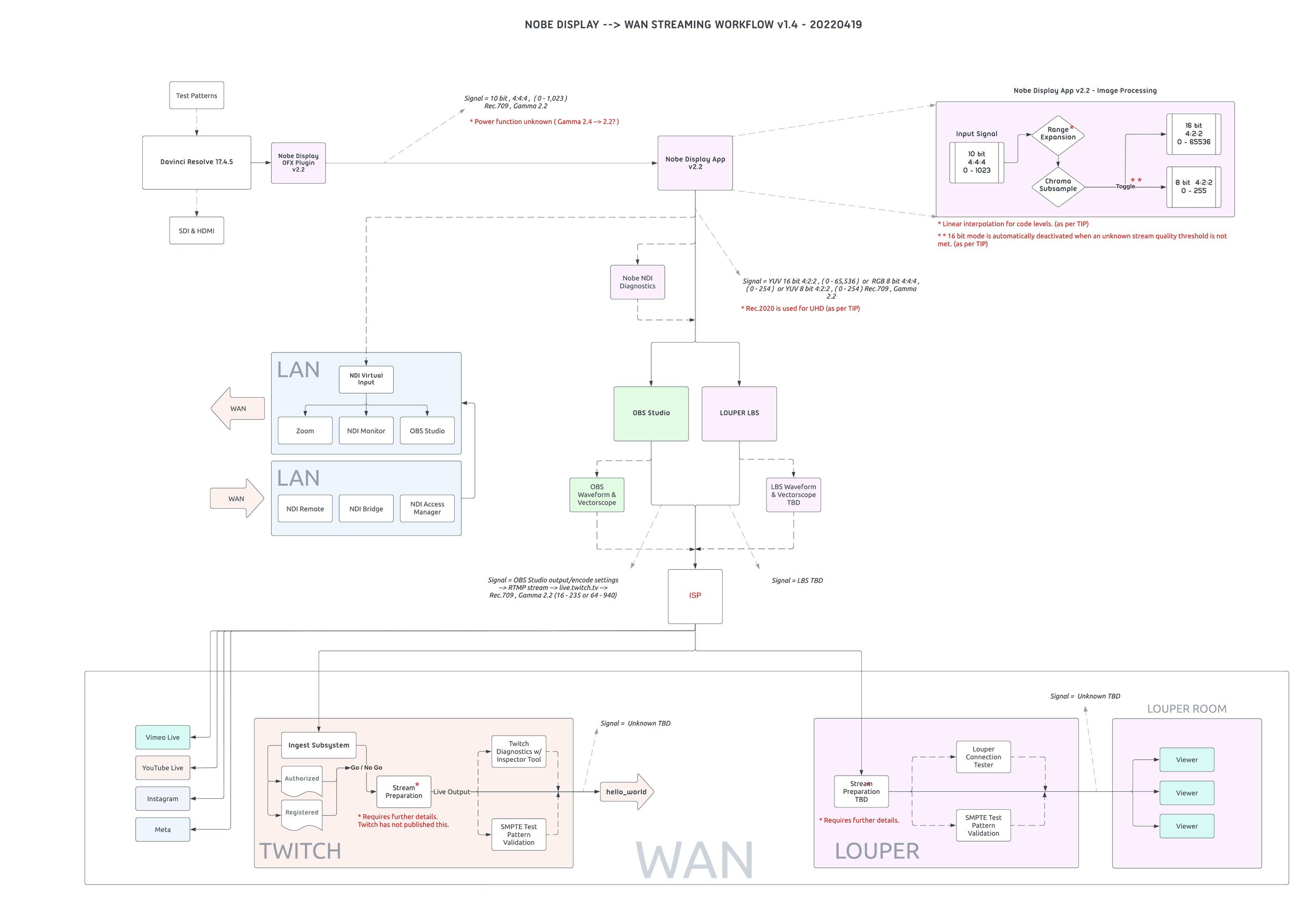During the pandemic, I engineered a low-latency, high-resolution video monitoring solution for remote color grading using NDI, NOBE Display, OBS, and Twitch/Looper, achieving near Rec. 709 accuracy (ΔE < 3) over standard internet connections.

When COVID-19 hit, colorists worldwide faced an existential crisis: how do you maintain the sacred client-colorist relationship when sharing the same air became a health hazard? The traditional scene of clients lounging on the studio couch while scrutinizing every nuance of their project’s grade suddenly seemed like a relic from a different era.
The Quest for Remote Color
As a professional colorist, I found myself at this crossroads. The challenge was clear: maintain color accuracy while streaming in real-time to remote clients. Commercial solutions existed, but they often came with enterprise-level price tags and complex installation requirements. Sometimes the best solutions are born from necessity, and armed with a bit of technical knowledge and a lot of determination, I set out to build something different.
Enter NDI: The Unsung Hero
Network Device Interface (NDI), developed by NewTek in 2015, turned out to be the foundation of this solution. Think of NDI as the TCP/IP-savvy cousin of SDI – it’s built for the age where video production increasingly lives on networks rather than traditional broadcast infrastructure. Running on standard 1, 2.5, or 10 gigabit networks, NDI brings some impressive features to the table:
- Automatic device discovery (like DHCP for video signals)
- Self-healing capabilities
- Network-wide video access
- Low-latency transmission
The Technical Pipeline
Here’s where things get interesting (and where my fellow tech enthusiasts might want to grab their notepads). The signal chain I developed looks like this:
- DaVinci Resolve → NOBE Display
- Input: 10-bit 4:4:4 (1023 code levels)
- Output: YUV 8-bit 4:2:2, Rec. 709 at gamma 2.2
- NOBE Display handles the heavy lifting of converting the signal to NDI
- NDI → OBS/Looper Broadcast Software (LBS)
- Real-time signal monitoring via waveform and vectorscope
- Quality control checkpoint #1
- LBS → Internet → Client
- Final signal transmission
- Choice of platforms:
- Twitch for non-sensitive projects
- Looper for privacy-conscious clients (password-protected, encrypted rooms)
Color Management: The Devil in the Details
Here’s where we enter the twilight zone between software engineering and color science. During development, I discovered an interesting gap: while there are plenty of brilliant developers creating streaming software, and plenty of color scientists perfecting standards, there’s surprisingly little overlap between these worlds. It’s like they’re speaking different languages – one in RGB, the other in TCP/IP.
The solution achieved a Delta E of around 3 – not quite meeting the professional standard of < 2, but more than adequate for most review scenarios. For context, these are often the same clients who review footage on Frame.io using Spider or DataColor-calibrated displays.
Quality Control: Trust, but Verify
To ensure signal integrity, I implemented a three-point verification system using SMPTE color charts:
- Source signal (ground truth)
- Local LBS output
- Final streamed signal
This allowed for precise tracking of any color shifts or degradation throughout the pipeline.
The Present and Future
Today, solutions like DaVinci Resolve’s built-in remote viewing protocol have made this specific setup less necessary. But the project represents something more important: the power of open-source tools and a bit of technical creativity to solve real-world problems. Sometimes you don’t need a commercial solution with five zeros in the price tag – just some NDI magic and a willingness to dive into the intersection of color science and streaming protocols.
Lessons Learned
- Open-source and commercial tools can achieve professional-grade results when properly configured
- The gap between color science and streaming technology expertise remains an opportunity for innovation
- In times of crisis, temporary compromises (like accepting Delta E of 3) can be acceptable if clearly communicated
- Having technical knowledge across multiple domains (color science, networking, video protocols) enables unique solutions
For those looking to experiment with similar setups, remember that color management is crucial every step of the way. And yes, you might find yourself explaining to a streaming engineer what gamma 2.2 means while simultaneously teaching a colorist about UDP packets. It’s all part of the fun.
Who knew that a pandemic would push us to bridge the gap between color science and streaming technology? Sometimes the best innovations come from simply refusing to accept that clients can’t see their projects in (almost) perfect color, even from their living rooms.
